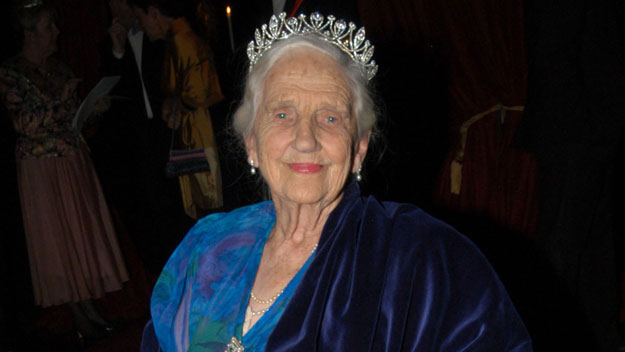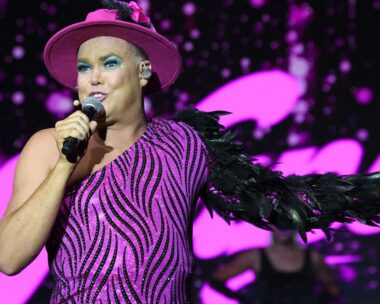A woman born in the Edwardian era could be forgiven for defining herself solely as a wife and mother, but there was much more to Dame Elisabeth Murdoch than the history-making men in her life.
Although her fateful union with legendary newspaperman Sir Keith Murdoch spawned the world’s most powerful media magnate, their son, Rupert, Dame Elisabeth’s legacy extends far beyond her illustrious family tree.
As one of the country’s most generous philanthropists, she touched countless Australian lives and won universal love and respect for her no-nonsense charm, modesty and compassion.
Nothing like a Dame: Elisabeth Murdoch, the modest matriarch
Investing her time and irrepressible energy in an endless array of charities, Dame Elisabeth gave of herself rather than merely her family fortune, and when she died earlier this month at the age of 103 — beyond what she called “a good innings” — the tributes reflected the extraordinary goodwill she had gathered over a lifetime of service.
“Dame Elisabeth Murdoch lived a great Australian life,” said Prime Minister Julia Gillard. “Her example of kindness, humility and grace was constant. She was not only generous, she led others to generosity. Australia’s children and Australia’s artists have lost one of their greatest benefactors.”
Rupert described his mum as a “great lady, wife, mother and citizen” who had demonstrated the best qualities of public service. “Her energy and personal commitment,” he said, “made our country a more hopeful place.”
As her 100th birthday approached, Dame Elisabeth said her number-one wish was “to go on being useful”. Indeed, she suspected the key to her long, fruitful life was her sense of purpose.
“I don’t waste time,” she once said. “I think that’s nothing to be highly praised for, but I think it does enable you to fill your life absolutely to the brim.”
We often look to centenarians to unlock the secrets of longevity, to extract some life lessons.
In Dame Elisabeth’s case, her altruistic work ethic, constant gratitude for her good fortune and hearty lust for life seemed to fortify her, propelling her into her second century.
She may have been small and silver-haired, but when she popped up at Melbourne fundraising events, as she often did, there was a magnetic quality about her.
Even at the age of 100 she maintained a relentless social schedule, going out four nights a week, whizzing around her garden in a golf buggy and enjoying family get-togethers twice a year with her grandchildren and great-grandchildren.
When Anna Murdoch Mann spoke to The Weekly a few years ago, she was full of admiration for her former mother-in-law, particularly her open-minded embrace of life.
“The children always felt they could speak to Granny more than they could to me when they were in their late teens,” said Anna, “because she kept a curious mind.”
In 2008, Dame Elisabeth said she was aiming for 105 — “in fact I’d like to live forever”.
At that stage she’d taken to avoiding mirrors (“it’s so displeasing”) because she didn’t want to be reminded of her age.
“I’m not conscious of my age at all,” she said. “You know your mind and your outlook is exactly the same.”
Indeed, in an interview with The Weekly when she was 94, she referred to the “poor old things” in their 80s confined to walking frames and wheelchairs.
For her family she provided an “example of enthusiasm, energy and achievement, all driven by the highest moral values”, Rupert once said.
She may have baulked at the “matriarch” label — to her mind, it sounded self-important — but she more than fit the bill.
According to Michael Wolff, who wrote the 2008 Rupert biography The Man Who Owns the News, Dame Elisabeth wielded amazing psychological power over her clan “by all manner of maternal forces and wiles”.
To the outside world, Rupert Murdoch may be “a man of infinite wealth and power”, wrote Wolff, but within his family the media baron was “his mother’s son — put in his place”.
Although she professed what she described as a shameful lack of interest in the family business (“I don’t care a hang about the newspapers,” she told Wolff. “I don’t care if I don’t see a newspaper for days. Terrible, isn’t it?”), Dame Elisabeth played confidante to both her husband and her son.
An extraordinary life: Dame Elisabeth Murdoch dies at 103
She took Rupert to task over the sensationalist tactics and racy content of his UK tabloids and he reportedly toned them down in response; he even kept the well-respected Australian newspaper running at a loss for almost 30 years “to deflect his mother’s disapproval”.
Dame Elisabeth also apparently let fly at her son — “uncomprehending and furious”, wrote Wolff — when Rupert took up with Wendi Deng after 31 years of marriage to Anna Murdoch.
“Rupert and I don’t always agree but we respect each other’s attitude,” she told Andrew Denton on the ABC Elders television series in 2008. “Oh, I express my views very strongly and Rupert listens to them.”
Her son was “a modern edition” of his father, she always said, driven not by money but challenge — although Rupert, she told The Weekly, was probably more ruthless than her husband, who was such a “softie” he used to fall sick with anxiety before having to sack an employee.
Dame Elisabeth, who often decried modern materialism, insisted she was proud of Rupert because he was a good father and son — not because of his jaw-dropping wealth.
She was a woman who would gladly hand out millions to worthy causes and yet she was a picture of financial restraint in her own life, eschewing heating in her house for decades and giving up a holiday overseas one year to install a pool in her garden.
Nothing like a Dame: Elisabeth Murdoch, the modest matriarch
The roots of her abiding frugality, and her deep aversion to ostentation, can perhaps be traced back to her childhood.
Born on February 8, 1909, the third daughter of wool valuer Rupert Greene and his wife, the former Marie de Lancey Forth — both members of the Melbourne establishment — Elisabeth grew up in Toorak in the days before telephones and refrigeration, when horse-drawn carriages outnumbered motor cars.
Although she was raised in a privileged milieu, her hard-drinking and gambling father meant the family was often in debt and had to rent out their home to pay the bills.
The charismatic Rupert doted on his youngest child but was short-tempered, she said, “rather egotistical and quite intolerant of any of our shortcomings”, while her long-suffering mother was a generous, kind-hearted role model.
Dame Elisabeth didn’t go to school until she was 11, but thrived once she started at Toorak’s St Catherine’s. She went on to attend the austere, unheated Mount Macedon boarding school, Clyde (which later amalgamated with Geelong Grammar), where she weathered brutal winter conditions, excelled in music and sport and was imbued with a strong service ethos.
As a schoolgirl, she knitted a prodigious number of woollen baby singlets for the Melbourne Children’s Hospital and as a reward was taken on a guided tour of the infirmary, where she was so upset by the sight of screaming babies coming out of theatre that she couldn’t return to boarding school the next day. Perhaps it was then that her destiny was set.
After high school, though, there was no consideration of a career. Instead, she “came out” in Melbourne society in 1927 and was presented to the visiting Duke and Duchess of York.
When Keith Murdoch — a celebrated war correspondent who had exposed the folly of the Gallipoli campaign and later become the influential editor of The Herald — saw a photograph of the 18-year-old debutante in Table Talk magazine he agreed to go to a charity ball on the proviso that he be introduced to the lovely Elisabeth.
Decades later, Dame Elisabeth could still recall falling under the spell of his “big, dark and compelling” eyes: “They just seemed to follow me around the room for the rest of the night.”
Melbourne’s most eligible bachelor, who went on to set up the first national media chain in Australia, was 23 years her senior but he was smitten, and a year later — despite fierce opposition from Elisabeth’s family and friends and the disdain of Melbourne high society — the pair were married.
As a wedding gift, Keith (who was knighted in 1933) gave his bride Cruden Farm, a 55-hectare property near Langwarrin on the Mornington Peninsula where his wife would cultivate one of the country’s most celebrated gardens and live for more than 80 years, opening up the two-storey neoclassical farmhouse with its soaring pillars to host innumerable fundraisers.
The couple had four children — Helen (later Handbury, who died in 2004), Rupert, Anne (Kantor) and Janet (Calvert-Jones) — but her husband was obviously Elisabeth’s first priority and “the rest of us had to be sent off to boarding school,” Rupert told his biographer.
It was a marriage built on great love and respect. “Mum and Dad were clearly devoted to one another,” Janet told her mother’s biographer, John Monks, in Elisabeth Murdoch: Two Lives.
“The only arguments I ever remember, and I don’t suppose that they were real arguments — but to me they seemed so serious — were the breakfast discussions on where to go for picnics.”
Dad was the indulgent one, while Mum was more of a strict, restraining influence. Nevertheless, Janet told Monks she could not remember her mother ever raising her voice: “I’ve never seen her in a bad mood, never known her to get cross with anyone.”
Always determined not to spoil her children, Dame Elisabeth said she “exercised a lot of loving discipline”; Michael Wolff went so far as to say Rupert was “treated with calculated cruelty to build character”.
As was common in those days, she taught five-year-old Rupert to swim by throwing him in the deep end of a pool and not letting anyone rescue him.
Much has also been made in the past about Rupert’s “teenage sleepout” at Cruden Farm, with its rock wall no more than head high, where he slept on a camp stretcher without heating or electricity.
“I felt boys ought to be tough,” Dame Elisabeth once told The Weekly. “It wasn’t anything unusual. If you spoil children you really are doing them a great injustice.”
An extraordinary life: Dame Elisabeth Murdoch dies at 103
From all reports, though, the Murdoch children enjoyed an idyllic, loving upbringing on the farm, riding horses, going on family picnics and catching rabbits.
Originally a weekend escape, Cruden Farm became the permanent family home and one of Elisabeth’s great passions after Sir Keith died.
The sprawling garden — where she planted a copper beech in his memory — artfully melds exotics and natives, boasts magnificent elms and oak trees and features a lake with ducklings and weeping willows.
In 1944, however, a bushfire almost destroyed the property. Elisabeth feared the 130 lemon-scented gum trees lining the drive were burned beyond redemption, but green shoots sprouted from the blackened trunks the following spring. “It was a miracle really,” she recalled. “But that’s Australian eucalypts for you. Very tough, very resilient creatures, the eucalypts.”
The same could be said for their custodian, for when her beloved husband died in his sleep in 1952, leaving her a 43-year-old widow faced with daunting debts, Elisabeth overcame her grief and reinvented herself with a steely determination, embarking on the second phase of her life.
Nothing like a Dame: Elisabeth Murdoch, the modest matriarch
At that stage she had already worked on the Royal Children’s Hospital management committee for two decades, initiating the Good Friday Appeal, but in 1954 she took over the presidency and spearheaded the building of the new hospital in Parkville.
In 1963, after 30 years of service, she was awarded the DBE the day the new hospital opened.
Although a widow for 60 years, the ever-optimistic Dame Elisabeth said she was never lonely: “My marriage, my happiness has strengthened me and carried me on.”
In 2008, she said she still felt the constant presence of her husband in her home, and even after her eldest child died in 2004, she managed to express gratitude for Helen’s final three months.
She had been afraid of her daughter dying but when asked how she dealt with the fear, she replied, “Oh, pull yourself together and get on with it. You can’t be worried about how you feel.”
Certainly not a navel gazer, she always strove to put others before herself. She may have mingled with royalty and heads of state, but she was modest to a fault.
She said she had “an awful cheek” as a teenager to think she was worthy of Keith, insisted she wasn’t a great gardener, and scoffed at the “ridiculous” revelation that she was considered a candidate for governor-general after the 1975 dismissal of prime minister Gough Whitlam (“Never in a million years would I have said ‘yes’,” she told her biographer).
“I’m very conscious that I never would have made much of a mark … unless I’d married Keith,” she once said, “and had the opportunities which he gave me and his position gave me.”
For the past 80 years, as “a form of thanksgiving” for the blessings in her life, Dame Elisabeth has supported countless charities across a broad range of interests, from the arts, community and education to medical research, wildlife and prisoner welfare.
She became the first female trustee of the National Gallery of Victoria in 1968, co-founded the Victorian Tapestry Workshop in 1976, and was a founding member of the Murdoch Institute (now known as the Murdoch Children’s Research Institute) in 1984.
For her, philanthropy meant more than dishing out cash. “I think if you’ve got money it’s perfectly easy to give it away and nothing to be particularly proud of,” said Dame Elisabeth, who supported about 110 charities annually.
An extraordinary life: Dame Elisabeth Murdoch dies at 103
Dame Elisabeth once crossed the Atlantic with Winston Churchill and was appalled by his all-night drinking and card-playing, but there’s no doubt she would have concurred with his maxim, “We make a living by what we get, but we make a life by what we give.”
On the eve of her 90th birthday, Dame Elisabeth summed up her guiding principle. “I believe it’s important to do whatever one can to help others,” she said. “That’s the way I’ve lived my life. And, you know, the reward’s been mine.”




